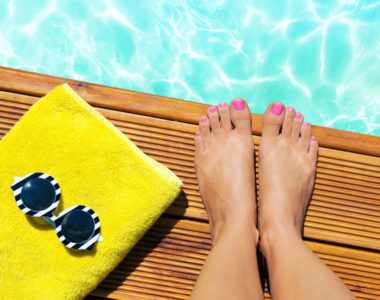 We tend to be a lot more active during the warm summer months, but this can lead to a lot more stress and pressure on our feet. In today’s blog, we take a closer look at five ways the summer weather can be hazardous on our feet, and we share some tips for preventing foot and ankle problems this summer.
We tend to be a lot more active during the warm summer months, but this can lead to a lot more stress and pressure on our feet. In today’s blog, we take a closer look at five ways the summer weather can be hazardous on our feet, and we share some tips for preventing foot and ankle problems this summer.
Summer Foot Hazards
Here’s a look at five activities or objects that can increase our likelihood of suffering a foot or ankle injury, and how you can prevent them from causing problems for your feet.
1. Going Barefoot – It can feel liberating to go barefoot during the warm summer and feel the grass beneath your feet, but it can also lead to cuts and injuries. Going barefoot can actually help develop key foot muscles, but you’ll only want to go barefoot in locations where there aren’t a number of hazards. Avoid rocky areas or lawns with thorny weeds, and be weary of going barefoot in areas where nails or other construction hardware could be left behind. Level grassy ground is great for going barefoot, but if you’ll be running or walking on other surfaces, consider protecting your feet with shoes.
2. Your Sandals – If you don’t want to go barefoot, you may opt for a breathable pair of sandals. While sandals are typically fine in moderation, wearing them daily isn’t always the best option for foot support. There’s very little arch support in your average pair of sandals, and if you’re curling your toes to help keep the sandal on your feet as you walk, you will be overworking certain muscle groups and putting yourself at risk for soft tissue injuries. Wear in moderation, and only if they are appropriate for the activity. If you’ll be doing a lot of walking, pick a more supportive shoe.
3. Sweat – The hot weather can also mean that our feet are sweating more than normal to help our body stay cool. Excess foot sweat can increase your risk of developing an infection or athlete’s foot. Change out of wet or damp socks as soon as possible, and invest in a more breathable (but supportive) shoe to help prevent excessive foot sweat.
4. Sunburn – Your feet are among the most overlooked body parts when it comes to applying sunscreen. We always hit our arms, legs and chest, but oftentimes we forget our feet. It’s also the body part that’s most commonly submerged in water, meaning even if we do apply sunscreen, it can quickly wash away. Make a point to regularly apply sunscreen to all sides of your feet this summer so that you can reduce the risk of sunburn and sun-related problems like skin cancer.
5. Blisters – Finally, if your sweaty feet are creating friction with your sock or shoe, it won’t be long before a blister develops. Untreated blisters can become painful and provide an entryway for dangerous bacteria to enter the body. If your sweaty feet are rubbing against a particular area of your shoe, or if you notice that you’re beginning to develop a blister on your feet, reconsider your footwear options.